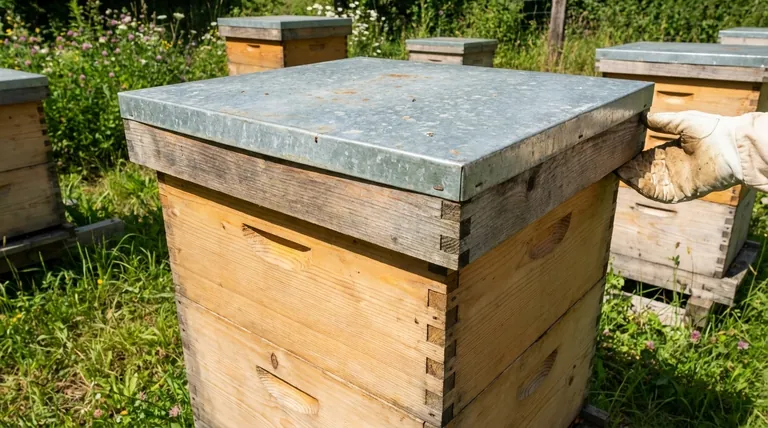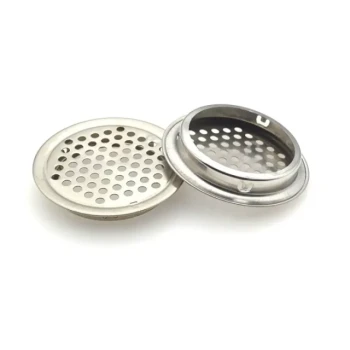A telescoping outer cover is a type of lid for a Langstroth beehive designed to provide maximum protection from the elements. Unlike simpler covers, its defining feature is that it "telescopes" or extends down over the top edges of the uppermost hive box, creating a protective shield against rain, snow, and wind.
The choice of a beehive cover is a decision between maximum environmental protection and operational efficiency. The telescoping cover prioritizes robust, all-weather defense for the colony, making it the standard for beekeepers in challenging climates.

What Defines a Telescoping Outer Cover?
The design of the telescoping cover is simple but highly effective. Its form is directly tied to its function of creating a weather-tight seal for the colony within.
The Overhanging Design Principle
The term "telescoping" refers to how the cover's sides hang down over the top super. This overhang is the critical design element.
Think of it like the eaves on a house roof. It ensures that rain and melting snow drip clear of the hive's sensitive top seams, preventing water from seeping into the hive.
The Role of the Metal Top
Nearly all telescoping covers are topped with a layer of galvanized metal. This sheet metal serves two essential purposes.
First, it provides a completely waterproof barrier. Second, it protects the underlying wood from weathering, warping, and rot, significantly extending the life of the component.
How It Works with the Inner Cover
The telescoping outer cover is designed to fit over an inner cover. The inner cover provides a layer of dead air space for insulation and helps manage the bees' access to the lid.
This two-part system is crucial for moisture management, especially in winter. The inner cover often has a notch that provides an upper entrance, which, combined with the protective outer cover, helps vent humid air.
Key Advantages for Colony Health
Choosing a telescoping cover directly impacts the colony's ability to regulate its environment, particularly in regions with harsh weather.
Superior Weatherproofing
The primary advantage is its unmatched ability to protect the hive from inclement weather. The overhanging design prevents rain from driving into the hive body joints.
This keeps the interior of the hive dry, reducing the risk of mold, chilled brood, and other moisture-related stresses on the colony.
Enhanced Durability and Longevity
The combination of its robust construction and the protective metal top makes the telescoping cover extremely durable.
It can withstand years of exposure to sun, rain, and snow without failing. This longevity makes it a sound long-term investment for hive equipment.
Aiding in Winter Condensation Management
During cold winters, the warm, moist air from the bee cluster rises and can condense on cold surfaces.
The telescoping cover, used with an inner cover, creates an insulated pocket of air that helps keep the top surface warmer, reducing condensation. This is vital for preventing cold water from dripping back down onto the bees.
Understanding the Trade-offs
While the telescoping cover offers superior protection, it comes with practical considerations that differentiate it from other options.
Increased Cost
Due to the more complex construction and the inclusion of a metal top, telescoping covers are more expensive than simpler alternatives.
Comparison with Migratory Lids
The most common alternative is the migratory lid, a simple flat board that sits flush with the hive body's edges.
Migratory lids are cheaper, lighter, and allow hives to be stacked tightly together on pallets for commercial pollination. However, they offer minimal protection from driving rain and have a shorter lifespan.
Making the Right Choice for Your Apiary
The decision between a telescoping cover and a migratory lid depends entirely on your climate, budget, and beekeeping goals.
- If your primary focus is stationary hives in a climate with cold winters or significant rainfall: The telescoping outer cover is the undisputed standard for ensuring colony health and equipment longevity.
- If your primary focus is budget-friendliness or commercial-scale operations requiring frequent hive moves: The simpler, cheaper migratory lid offers a more practical and efficient solution.
Ultimately, investing in the right equipment is a foundational step in responsible and successful beekeeping.
Summary Table:
| Feature | Telescoping Outer Cover | Migratory Lid |
|---|---|---|
| Weatherproofing | Superior (overhanging design) | Minimal |
| Durability | High (metal top protects wood) | Lower |
| Condensation Management | Excellent (with inner cover) | Poor |
| Cost | Higher | Lower |
| Best For | Challenging climates, stationary hives | Budget-friendly, commercial moving operations |
Protect your apiary investment with the right equipment. As a trusted wholesale supplier to commercial apiaries and distributors, HONESTBEE provides durable, high-performance telescoping outer covers designed for long-term colony health. Contact our team today to discuss your bulk supply needs and ensure your hives are equipped for success.
Visual Guide

Related Products
- Telescopic Beehive Outer Cover Lid Roof with Galvanised Sheeting for Langstroth Hive and Beehive Outer Cover
- Professional Insulated Winter Hive Wrap for Beekeeping
- Long Langstroth Style Horizontal Top Bar Hive for Wholesale
- Wholesales Dadant Size Wooden Bee Hives for Beekeeping
- HONESTBEE Professional Long Handled Hive Tool with Precision Cutting Blade
People Also Ask
- What is the purpose of a garden hive lid in beekeeping? Essential Protection for Your Colony's Health
- What is the function of the top cover in a Langstroth hive? Master Hive Protection & Climate Control
- What is the purpose of the inner and outer covers in a beehive? Essential for Hive Health & Management
- What are the features of the peaked roof in Langstroth hives? Superior Weather Protection & Stability
- How do you install the Langstroth hive roof? A Step-by-Step Guide for a Healthy Colony



















